Introduction
Delhi has always remained a melting pot of several different cultures since the ancient times, started by the Delhi Sultanate combining regional Indian habits with that of Persian and Turkish world. Which was heightened by the Mughals and their extravagant nature. These transformations of society taking place over the course of thousands of years is most visible under the study of architecture and the last piece of Delhi’s architectural history was put on place by British. They combined several European styles with that of Indian under the 8th city of Delhi state i.e. New Delhi (rest 7 being medieval i.e. Qila Rai Pithora, Siri, Tughlaqabad, Jahanpanah, Firozabad, Shergarh (Purana Qila), and Shahjahanabad).
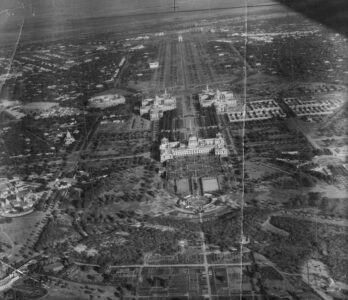
This new city is often called Lutyens’ Delhi or Lutyens Bungalow Zone deriving its name from the Chief Architect Edwin Landseer Lutyens
Origin: Planning a New Capital
The foundation of new city was laid up by the announcement of changing British India’s capital from Calcutta to Delhi. The political landscape of Calcutta was turned out to be very turbulent and chaotic and need was arrived to divide Bengal presidency into Eastern Bengal and Assam. Following these developments the change in Capital location was announced in king George V’s coronation durbar held in 1911 in Delhi. To shift the Government of India’s administration to the traditional seat was a highly debatable decision, while the people of Delhi and surrounding places were pleased, the elites and Europeans living in Calcutta felt betrayed. They couldn’t criticize the king but furious newspaper articles were written against Hardinge the Governer General of India.
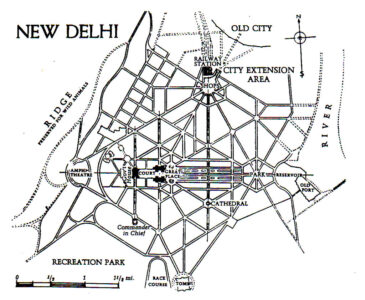
With this decision Delhi’s skyline was bound to change and several changes did started happening, electricity, tramways and railway lines were being setup. They planned to transform Delhi into a Capital City bigger than London. This task was taken by skillful designers and architects like Edwin Lutyens and Herbert Baker along with around 29,000 laborers.
This was a behemoth task and municipality realized the social and political gravity of this situation early on. The Town Planning Committee headed by Lutyens was set up to make this process smooth. The committee chose land below Shahjahanabad around Raisina hills as the location for new city. Families of laborers, immigrants and displaced were moved to West Delhi. The Town Planning Committee also decided for the building of Army Cantonment, Railway Expansion and a symmetrical, even design for city unlike the uneven development of other areas.
Basis of Architecture
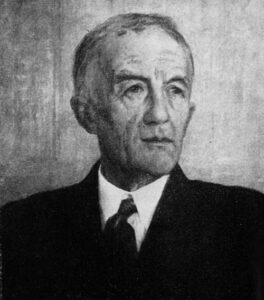
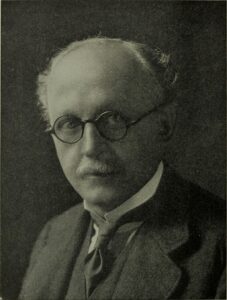
The new capital of British Raj was designed to be a symbol of imperial power, prestige and permanence. Edwin Lutyens was inspired by the works of Christopher Wren and wanted to build it fully based on European Neoclassical and British Imperial style. Lutyens was rather disrespectful towards traditional Indian Architecture as he wrote in a letter to Baker in 1903, “Personally, I do not believe there is any real Indian architecture or any great tradition.” Baker was no different either, he believed that architecture only serves political purpose. A value vastly different than Indian structures that served purposes like aesthetic, functional and showing prestige. According to Baker architecture had to be ‘not Indian, nor English, nor Roman,’ but simply imperial as published in The Times newspaper dated 3rd October 1912.
Hardinge the Governor General of India was appalled by this design and insisted upon the usage of Indian traditions combining it with the European styles. Swinton Jacob was appointed as the advisor for Indian Arts and chief architects were advised to take inspiration from old Indian forts. Hardinge wanted to gain the trust of his subjects while showcasing the grandeur of British Raj. He wanted Indian people to see Imperial rule as worthy successors of Mughals and feel equally proud. Thus a new style was put in place that is Indo-Saracenic.
Lutyens was given the main attraction of city the Viceroy’s House (currently known as Rashtrapati Bhavan) and Baker was given secretariat block to design. They used red sandstones for building and had features like colonnades, chhatris, jaalis, chhajja, and verandah. These were tools to copy Mughal style and to impress Indians, to receive the same level of respect, legitimacy and authority that Indians once gave to earlier Emperors.
Structures, Features & Motifs
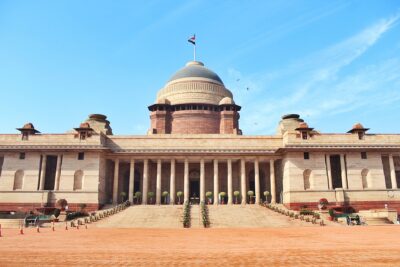
These structures that were meant to showcase Indian unity under British umbrella had several features taken from both the local styles and European classicism.
Main building of this complex was Viceroy’s House now known as Rashtrapati Bhavan built on Baroque style of architecture. It was a humongous project with four floors, and 340 rooms spamming across 19,000 square meters. Indian motifs that were implemented was Mughal inspired domes and symmetrical gardens, and elephant sculptures to symbolize dominance and might.
Second most important structure that is Baker’s Secretariat now known as Old Parliament, is more Indian in style than neoclassical. Baker realized that as a seat of ministers and princes it will be visited by more Indians on a regular basis as compared to Viceroy’s House. It is a circular structure with a diameter of 170.69 meters. The circular shape is probably inspired by Chausath Yogini Temple of Madhya Pradesh. It has extensive use of local motifs like chhatris, chhajas, jaalis, and even floral decorative patterns.
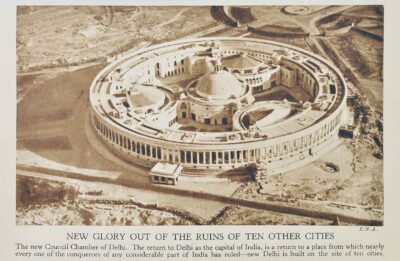
Other important structure being All India War Memorial now known as India Gate. It is a triumphant arch that contains names of 13,000 soldiers, honoring the martyrs of World War 1. This 42 meter tall arch is made up using local resources like yellow sandstone and red and yellow granite.
Several other features and motifs were included based on the environmental demands like open verandahs, spacious colonnades, porticoes, small high window openings and overhanging eaves. These features were also famously used in the colonial structures of South Africa due to it’s suitability for tropical climate.
Conclusion
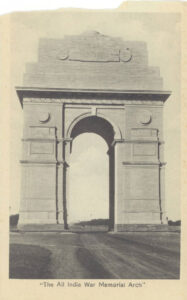
The capital complex of New Delhi contained grandeur never seen before in British Empire, to work as the designer of this city was highest achievement for any architect. It was meant to connect not just India’s earlier rules with Britain but also to signify the achievements of entire British Empire. The city was completed in 1931, and Robert Byron a writer who saw it in 1930s describe it as, “People don’t realize what has been done, how stupendous it is, and such a work of beauty, so unlike the English.”
New Delhi will go on to attract several political attention becoming the hub for nationalistic movement of independence. Even today, Lutyens’ Delhi has remained as the face and seat of Government of India.
References
- Metcalf, T.R. Architecture and Empire: Sir Herbert Baker and the Building of New Delhi. In ‘Delhi Through the Ages’, ed. Frykenberg, R. E. Oxford University Press.
- Gupta, N. Delhi Between Empires 1803-1931: Society, Government and Urban Growth. Oxford University Press.
- Frykenberg, R. E. The Coronation Durbar of 1911: Some Implications. In ‘Delhi Through the Ages’, ed. Frykenberg, R. E. Oxford University Press.
- Mishra, Abhinav. Building New Delhi-Imperial Ideology and Urban Morphology. School of Open Learning, University of Delhi.
- Dalrymple, William & Sharma, Yuthika. Princes and Painters in Mughal Delhi, 1707-1857. Asia Society




